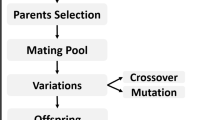Abstract
The Needleman-Wunsch (NW) is a dynamic programming algorithm used in the pairwise global alignment of two biological sequences. In this paper, three sets of parallel implementations of the NW algorithm are presented using a mixture of specialized software and hardware solutions: POSIX Threads-based, SIMD Extensions-based and a GPU-based implementations. The three implementations aim at improving the performance of the NW algorithm on large scale input without affecting its accuracy. Our experiments show that the GPU-based implementation is the best implementation as it achieves performance 72.5X faster than the sequential implementation, whereas the best performance achieved by the POSIX threads and the SIMD techniques are 2X and 18.2X faster than the sequential implementation, respectively.







Similar content being viewed by others
Notes
Indel is a term used for both the insertion and deletion operations in biological sequences.
References
Alsmirat MA, Jararweh Y, Al-Ayyoub M, Shehab MA, Gupta BB (2017) Accelerating compute intensive medical imaging segmentation algorithms using hybrid cpu-gpu implementations. Multimed Tools Appl 76(3):3537–3555
Balhaf K, Alsmirat MA, Al-Ayyoub M, Jararweh Y, Shehab MA (2017) Accelerating levenshtein and damerau edit distance algorithms using gpu with unified memory. In: 2017 8th international conference on information and communication systems (ICICS). IEEE, pp 7–11
Balhaf K, Shehab MA, Wala’a T, Al-Ayyoub M, Al-Saleh M, Jararweh Y (2016) Using gpus to speed-up levenshtein edit distance computation. In: 2016 7th international conference on information and communication systems (ICICS). IEEE, pp 80–84
Butenhof DR (1997) Programming with POSIX threads. Addison-Wesley Professional, Boston
Chan S, Wong A, Chiu D (1992) A survey of multiple sequence comparison methods. Bull Math Biol:563–598
Cook S (2012) CUDA programming: a developer’s guide to parallel computing with GPUs. Newnes, p 16–25
De Oliveira Sandes E, Miranda G, Martorell X, Ayguade E, Teodoro G, Magalhaes Alves de Melo AC (2016) Cudalign 4.0: incremental speculative traceback for exact chromosome-wide alignment in GPU clusters. IEEE Trans Parallel Distrib Syst 27(10):2838–2850
Durbin R, Eddy S, Krogh A, Mitchison G (1998) Biological sequence analysis. Cambridge University Press, Cambridge
El-Metwally S, Ouda O, Helmy M (2014) Next generation sequencing technologies and challenges in sequence assembly. Springer Sci Bus 7:16–25
Fakirah M, Shehab MA, Jararweh Y, Al-Ayyoub M (2015) Accelerating needleman-wunsch global alignment algorithm with gpus. In: 2015 IEEE/ACS 12th international conference of computer systems and applications (AICCSA). IEEE, pp 1–5
Farrar M (2007) Striped smith-waterman speeds database searches six times over other simd implementations. Bioinformatics 23(2):156–161
Gebali F (2011) Algorithms and parallel computing, vol 84. Wiley, New York
Gotoh O (1982) An improved algorithm for matching biological sequences. J Mol Biol 162(3):705–708
Jones C, Pevzner P (2004) An introduction to bioinformatics algorithms. MIT press, Cambridge
Katoh K, Toh H (2008) Recent developments in the mafft multiple sequence alignment program. Brief Bioinform 92:86–98
Liu Y, Schmidt B (2015) Gswabe: faster gpu-accelerated sequence alignment with optimal alignment retrieval for short dna sequences. Concurr Comput: Pract Exper 27 (4):958–972
Lomont C (2011) Introduction to intel advanced vector extensions. White paper, Intel
Needleman-wunsch algorithm. https://en.wikipedia.org/wiki/Needleman-Wunsch_algorithm [Online; accessed July-2015]
Needleman SB, Wunsch CD (1970) A general method applicable to the search for similarities in the amino acid sequence of two proteins. J Mol Biol 48(3):443–453
Rognes T (2011) Faster Smith-Waterman database searches with inter-sequence SIMD parallelisation. BMC Bioinform 12:221. https://doi.org/10.1186/1471-2105-12-221
Rognes T, Seeberg E (2000) Six-fold speed-up of smith-waterman sequence database searches using parallel processing on common microprocessors. Bioinformatics 16(8):699–706
Sanders J, Kandrot E (2010) CUDA by example: an introduction to general-purpose GPU programming. Addison-Wesley Professional, Boston
Serrano JP, De Oliveira Sandes E, Magalhaes Alves de Melo A, Ujaldon M (2017) Smith-waterman acceleration in multi-gpus: a performance per watt analysis. In: Bioinformatics and biomedical engineering - 5th international work-conference, IWBBIO 2017, Granada, Spain, April 26–28, 2017, Proceedings, Part II, pp 512–523
Setubal J, Meidanis J (1997) Introduction to computational molecular biology. PWS Pub, Boston
Shehab MA, Al-Ayyoub M, Jararweh Y (2015) Improving fcm and t2fcm algorithms performance using gpus for medical images segmentation. In: 2015 6th international conference on information and communication systems (ICICS), pp 130–135
Siriwardena P, Ranasinghe N (2010) Accelerating global sequence alignment using cuda compatible multi-core gpu. In: 5th international conference in information and automation for sustainability (ICIAFS), pp 201–206
Vermij P (2011) Genetic sequence alignment on a supercomputing platform. Doctoral dissertation, TU Delft, Delft University of Technology
Wozniak A (1997) Using video-oriented instructions to speed up sequence comparison. Comput Appl Biosci: CABIOS 13(2):145–150
Zhou W, Zhanxiu C, Lian B, Wang J, Jianping M (2017) Protein database search of hybrid alignment algorithm based on gpu parallel acceleration. J Supercomput. https://doi.org/10.1007/s11227-017-2030-x
Zhu X, Li K, Salah A, Shi L, Li K (2015) Parallel implementation of MAFFT on cuda-enabled graphics hardware. IEEE/ACM Trans Comput Biol Bioinform 12(1):205–218. https://doi.org/10.1109/TCBB.2014.2351801
Acknowledgments
The authors would like to thank the Deanship of Research at the Jordan University of Science and Technology for funding this work, grant number 20150050. Also, they would like to thank Alexandros Stamatakis and Tomas Flouri from HITS, Germany, for their support.
Author information
Authors and Affiliations
Corresponding author
Rights and permissions
About this article
Cite this article
Jararweh, Y., Al-Ayyoub, M., Fakirah, M. et al. Improving the performance of the needleman-wunsch algorithm using parallelization and vectorization techniques. Multimed Tools Appl 78, 3961–3977 (2019). https://doi.org/10.1007/s11042-017-5092-0
Received:
Revised:
Accepted:
Published:
Issue Date:
DOI: https://doi.org/10.1007/s11042-017-5092-0




